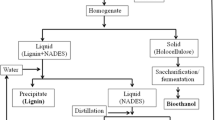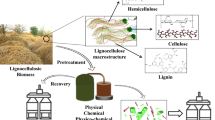Abstract
Due to its hydrophobicity and high energy yielding, butanol emerged as an important industrial solvent and superior liquid fuel with a potential to replace gasoline. The economic production of butanol is mainly depending on raw material cost. Thus, the development of butanol production process using renewable energy sources such as lignocellulosic crop residues has gained interest. In the present study, production of butanol from sugarcane field residue (SFR) was carried using newly isolated solventogenic Clostridium beijerinckii YVU1. SFR is one of the abundant lignocellulosic potential substrate available in the tropical world. SFR contains 40.3 ± 3.5% cellulose, 28.5 ± 3.0% hemicellulose and 20.3 ± 2.6% lignin. The sequential dilute alkali and acid pretreatment was solubilized around 69% of lignin and 73% of hemicellulose. Ten percent (w/v) of pretreated substrate was subjected to enzymatic saccharification with cellulase, and it released 0.681 ± 0.041 g of glucose/g of pretreated biomass. In the batch fermentation process, 22.8 g/l ABE with 16.5 g/l of butanol, 4.8 g/l of acetone and 1.5 g/l of ethanol was obtained. The performed fermentation process yielded 0.41 g of ABE/g of hydrolysate with 0.16 g/l/h productivity. The current work presents the impact of sequential alkali and acid pretreatment on the enzymatic hydrolysis of SFR as well as its utilization for butanol production by newly isolated C. beijerinckii YVU1. The outcome of the present work could be useful for further development in utilization of various crop residues for economical butanol production.




Similar content being viewed by others
References
APED. 2014. http://aped.in/agriexchange/India%20Production/India_Productions.aspx?cat=Agri.
Boopathy, R., B.R. Asrabadi, and T.G. Ferguson. 2002. Sugar cane (Saccharum officinarum L) burning and asthma in Southeast Louisiana, USA. Bulletin of Environmental Contamination and Toxicology 68: 173–179.
Dawson, L., and R. Boopathy. 2007. Use of post-harvest sugarcane residue for ethanol production. Bioresource Technology 98: 1695–1699.
Dürre, P. 2007. Biobutanol: An attractive biofuel. Biotechnology Journal 2: 1525–1534.
Ezeji, T., and H.P. Blaschek. 2008. Fermentation of dried distillers’ grains and soluble (DDGS) hydrolysates to solvents and value-added products by solventogenic clostridia. Bioresource Technology 99: 5232–5242.
Franco, H.C.J., M.T.B. Pimenta, J.L.N. Carvalho, P.S.G. Magalhães, C.E.V. Rossell, O.A. Braunbeck, A.C. Vitti, O.T. Kölln, and J.R. Neto. 2013. Assessment of sugarcane trash for agronomic and energy purposes in Brazil. Scientia Agricola 70: 305–312.
Han, L., J. Feng, S. Zhang, Z. Ma, Y. Wang, and X. Zhang. 2012. Alkali pretreated of wheat straw and its enzymatic hydrolysis. Brazilian Journal of Microbiology 43: 53–61.
Hiloidhari, M., D. Das, and D.C. Baruah. 2014. Bioenergy potential from crop residue biomass in India. Renewable and Sustainable Energy Reviewes 32: 504–512.
Jesse, T.W., T.C. Ezeji, N. Qureshi, and H.P. Blaschek. 2002. Production of butanol from starch-based waste packing peanuts and agricultural waste. Journal of Industrial Microbiology and Biotechnology 29: 117–123.
John, Kuo. 2014. Processing plant tissues for ultrastructural study. In Electron Microscopy: Methods and protocols, ed. John Kuo. New York: Springer.
Kerr, R.A., and R.F. Service. 2005. What can replace cheap oil—and when? Science 309: 101–104.
Liu, Z., Y. Ying, F. Li, C. Ma, and P. Xu. 2010. Butanol production by Clostridium beijerinckii ATCC 55025 from wheat bran. Journal of Iindustrial Microbiology and Biotechnolology 37: 495–501.
Macedo, I.C., J.E.A. Seabra, and J.E.A.R. Silva. 2008. Green house gases emissions in the production and use of ethanol from sugarcane in Brazil: 2005/2006 averages and a prediction for 2020. Biomass and Bioenergy 32: 582–595.
Miller, G.L. 1959. Use of dinitrosalicylic acid reagent for determination of reducing sugar. Analytical Chemistry 31: 426–428.
Nielsen, D.R., E. Leonard, S.H. Yoon, H.C. Tseng, C. Yuan, and K.L.J. Prather. 2009. Engineering alternative butanol production platforms in heterologous bacteria. Metabolic Engineering 11: 262–273.
Pandey, A., S. Biswas, R.K. Sukumaran, and N. Kaushik. 2009. Study on availability of Indian biomass resources for exploitation: A report based on a nation-wise survey. TIFAC, New Delhi 105.
Qureshi, N., M.J. Bowman, B.C. Saha, R. Hector, M.A. Berhow, and M.A. Cotta. 2012. Effect of cellulosic sugar degradation products (furfural and hydroxymethyl furfural) on acetone–butanol–ethanol (ABE) fermentation using Clostridium beijerinckii P260. Food and Bioproducts Processing 90: 533–540.
Qureshi, N., T.C. Ezeji, J. Ebener, B.S. Dien, M.A. Cotta, and H.P. Blaschek. 2008. Butanol production by Clostridium beijerinckii. Part I: Use of acid and enzyme hydrolyzed corn fiber. Bioresource Technology 99: 5915–5922.
Qureshi, N., B.C. Saha, B. Dien, R.E. Hector, and M.A. Cotta. 2010a. Production of butanol (a biofuel) from agricultural residues: Part I—Use of barley straw hydrolysate. Biomass and Bioenergy 34 (4): 559–565.
Qureshi, N., B.C. Saha, R.E. Hector, B. Dien, S. Hughes, S. Liu, L. Iten, M.J. Bowman, G. Sarath, and M.A. Cotta. 2010b. Production of butanol (a biofuel) from agricultural residues: Part II—Use of corn stover and switchgrass hydrolysates. Biomass and Bioenergy 34 (4): 566–571.
Ranjan, A., S. Khanna, and V.S. Moholkar. 2013. Feasibility of rice straw as alternate substrate for biobutanol production. Applied Energy 103: 32–38.
Schubert, C. 2006. Can biofuels finally take center stage? Nature Biotechnology 24: 777–784.
Sindhu, R., P. Binod, K. Satyanagalakshmi, K.U. Janu, K.V. Sajna, N. Kurien, R.K. Sukumaran, and A. Pandey. 2010. Formic acid as a potential pretreatment agent for the conversion of sugarcane bagasse to bioethanol. Applied Biochemistry and Biotechnology 162: 2313–2323.
Sindhu, R., M. Kuttiraja, P. Binod, K.U. Janu, R.K. Sukumaran, and A. Pandey. 2011. Dilute acid pretreatment and enzymatic saccharification of sugarcane tops for bioethanol production. Bioresource Technology 102: 10915–10921.
Sluiter, A., B. Hames, R. Ruiz, C. Scarlata, J. Sluiter, D. Templeton, and D. Crocker. 2008. Determination of structural carbohydrates and lignin in biomass. Washington, DC: National Renewable Energy Laboratory-NREL.
van der Wal, H., L.H.M. Sperber Bram, B. Houweling-Tan, R.R.C. Bakker, W. Brandenburg, and A.M. López-Contreras. 2013. Production of acetone, butanol, and ethanol from biomass of the green seaweed Ulva lactuca. Bioresource Technology 128: 431–437.
Acknowledgements
The authors would like to acknowledge the Department of Science and Technology (DST) and Council of Scientific and Industrial Research (CSIR), Government of India, for the financial support given in the form of a research Projects entitled “Biotechnological production of acetone–butanol–ethanol (ABE) from agricultural biomass using solventogenic bacteria” (Ref No.: SR/FT/LS-79/2009) and “Studies on Rapid and Enhanced Production of Ethanol through Very High Gravity (VHG) Fermentation” (Ref No.: 38 (1310)/11/EMR-II), respectively.
Author information
Authors and Affiliations
Contributions
ASV carried out the bench work and produced the results. LVR participated in the design of the study and writing of the manuscript. YJW conceived the study and participated in analyzing the results and correcting the manuscript.
Corresponding author
Ethics declarations
Conflict of interest
The authors declare that they have no conflict of interest.
Rights and permissions
About this article
Cite this article
Reddy, L.V., Veda, A.S. & Wee, Y.J. Utilization of Sugarcane Field Residue (SFR) as Renewable Feedstock for Biobutanol Production. Sugar Tech 20, 168–174 (2018). https://doi.org/10.1007/s12355-017-0546-2
Received:
Accepted:
Published:
Issue Date:
DOI: https://doi.org/10.1007/s12355-017-0546-2




